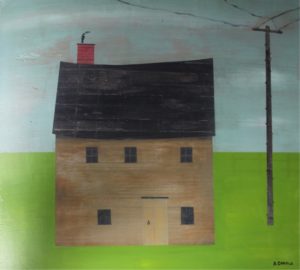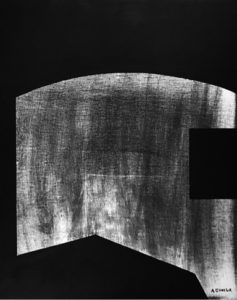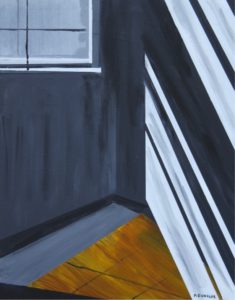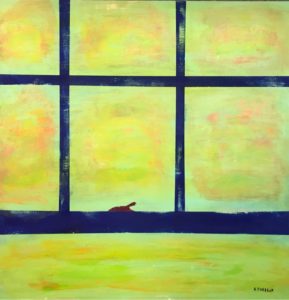December 24, 2018
Each Christmas, for a few decades now, my son, teacher Arthur H. Gunther IV, has taken my former newspaper column and now online space to offer a holiday story. Here it is for 2018.
By Arthur H. Gunther IV
It had kind of consumed him, this quest to slow down time. Where once he might have tried to possess it, his focus had gradually shifted to simply sharpening his vision. At least, that was what he told himself. There were certain tricks he had learned over the years. Time lived in places that he visited with regularity, but then again, time lived in places he hadn’t yet been. It was hard to explain, so he really didn’t bother. He was content to just show by example. By how he lived his days.
The trunk of John’s VW rabbit was nothing special. The car was a hatchback, so opening the back caused the cloth-covered platform behind the rear seats to lift up and reveal the bucket-shaped opening. It it, he kept an old wool blanket, jumper cables for when the battery died, a lead pipe to help loosen lug nuts, a jack, a full-sized spare tire, a scarf, a few newspapers for whenever he had to wait somewhere, and a weathered gray towel. Inside the towel, rolled up tight to protect the lens and the metal frame, was his camera. There was always a roll of film inside, black and white, with at least a few frames left to shoot. He never left a completed roll inside the camera. The minute it was finished he took it out to develop the shots.
No matter where John drove, the camera was always there. Sometimes he would go for weeks without taking it out. Before his kids were born, John would often drive just to wander, just to see where he would end up. This is when his camera would come out. Portraits and sunsets didn’t interest him. You wouldn’t find panoramic shots of any kind. John preferred photos with little plan, taken quickly the second the beauty within the frame revealed itself. A box in John’s basement held the results of his efforts. There were shadows made by oak leaves on old brick walls, sunlight on side street shop windows, barns nestled beside weathered houses from the last century.
John would develop the photos in his basement, look at them for a time, and then put them in a box. Sometimes he would go back to glance at the old photos, but more often than not the box is where they remained. It was as if the act of taking the photos, the drive and the wandering, were what really mattered. The photos in the box were almost beside the point.
With his kids getting older and his life getting more complicated, John’s drives, his wandering photo excursions, were less frequent. He would sometimes worry, when he had the time for such indulgence, that not taking the time for the photos actually had a role in accelerating time’s passage. If he got out, if he took the time to wander and use his camera, everything would slow down and come into focus. His memory sharpened once again. Thoughts would form. The unappreciated became appreciated once more.
John woke up one December morning, a few days before Christmas, daydreaming about Thanksgiving, about the coming holiday, before realizing it was already past. Later that day he drove home only to find his house empty. He checked the notepad always left on the kitchen counter and found three notes, all letting him know that his wife, daughter, and son had gone their separate ways for the afternoon. Shocked at finding his house empty, John’s first inclination was to wash the pile of dirty dishes in the sink, or maybe to start a load of laundry. As he was reaching to turn on the radio, his eyes fell upon a drawing his daughter had recently taped to the refrigerator of one of her old sneakers. The pause this image gave him was all John needed to grab his coat and get in his car. The dishes and laundry could wait.
The wind was picking up as John drove down toward the river and then up the side of Tallman Mountain toward the end of the county and the New Jersey border. He had stopped listening to weather reports a few years ago. He couldn’t take the disappointment of the uneven forecasts: rain in January, 50 degrees in July. This way, snowstorms and the other beauty of the seasons came as a surprise. At least he could dream. For all John knew, a blizzard was imminent.
John’s initial plan was to maybe walk the cinder bike path once he got past Piermont, but as was his wont, he changed his mind and instead continued past the entrance before turning down into the maze of roads that made up Sneden’s Landing. Parking at the old church near the beginning of the neighborhood, John got out, grabbed his camera from the trunk, and started walking. John descended the hill, once again amazed at the quiet that always pervaded the hillside. As he rounded a turn that was bordered by a giant elm tree, John came upon a young girl sitting on a bench. John had seen this bench before. It was really just a piece of wood balanced on two old stumps. He assumed it was a place where children sat waiting for the school bus.
“Hi.” The girl offered John a smile. “Going for a walk?”
“Yes, I guess I am,” John replied. “What’s up?”
“Nothing at all,” she replied. “I’m just waiting.”
“Waiting for what?” John couldn’t help but ask.
“Waiting for the snow. It’s going to snow. It’s almost Christmas.”
John almost replied with another question, but stopped himself. He had asked too many already. Instead, his eyes looked over to the old tree. On it’s gnarled, imposing trunk was nailed a plain, metal thermometer. He could see the mercury had settled right under the freezing point, where someone had drawn a red line with a pen. Taking out his camera, John snapped a closeup of the thermometer with just enough of the elm tree showing in the frame. Just as the click of the shutter had finished its reverberations, John heard the excited shout of the girl on the bench.
Swinging his gaze in her direction, John could see that snow had suddenly started falling. Flakes filled the air. The girl looked absolutely delighted, but not the least bit surprised. John stood for several seconds, or maybe even a minute, and then wished the girl a good night.
Walking back up the hill to his car, John’s thoughts settled upon a quote he had once heard by Aristotle: To appreciate the beauty of a snowflake, it is necessary to stand out in the cold. John hugged his camera close to his side. He couldn’t wait to get back home and see his family.
The writer is a first-grade teacher at the William O. Schaefer School in Tappan, N.Y. Reach him via clausland@yahoo.com




